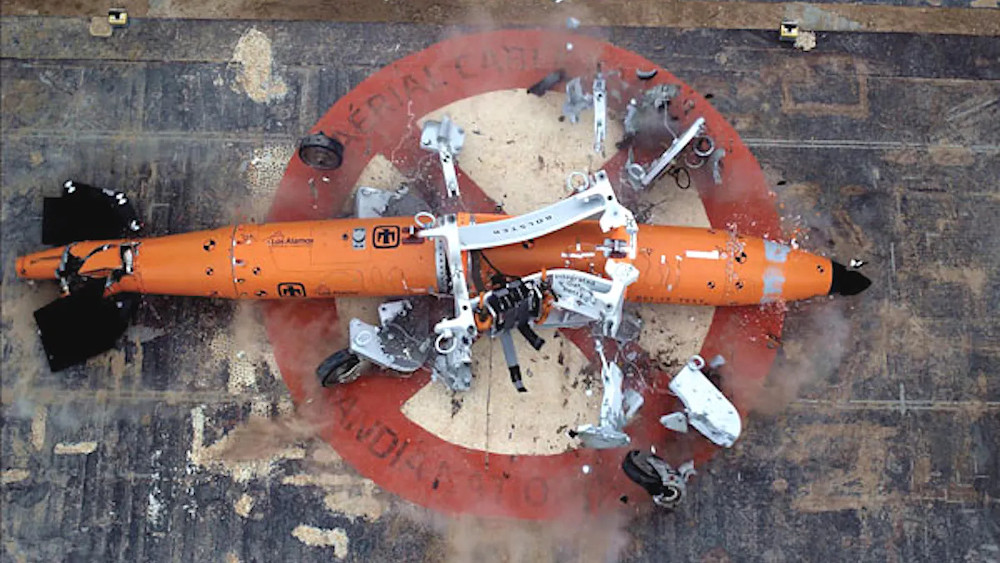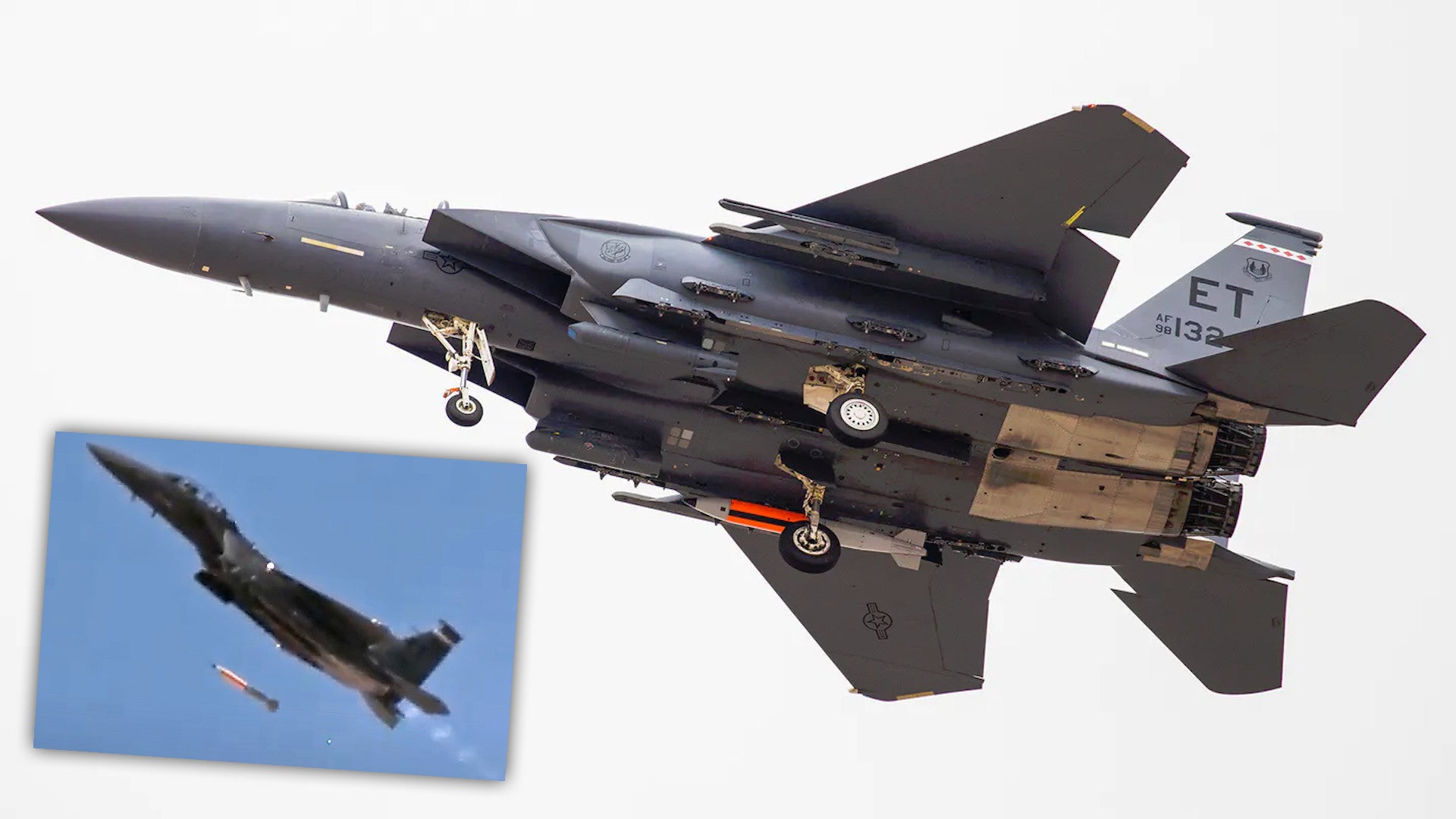The U.S. Air Force’s F-15E Strike Eagle has become the first aircraft type certified to deliver the United States’ B61-12 nuclear gravity bomb following a series of tests over the Tonopah Test Range in March. The War Zone
was first to report that month on a sighting of an F-15E carrying an inert B61-12 at Nellis Air Force Base in Nevada, which oversees the sprawling Nevada Test and Training Range, inside which the Tonopah Test Range is situated. This particular F-15E was certainly among those involved in this testing of America’s latest nuclear bomb, each of which will cost more than their weight in gold, literally.
The Department of Energy’s Sandia National Laboratories, which has been leading the development of B61-12 under the auspices of the National Nuclear Security Administration, announced the completion of the latest round of flight testing, and subsequent certification of the F-15E to employ the weapon, on June 8, 2020. The final two end-to-end flight tests in March demonstrated Air Force crews’ ability to handle, load, and otherwise simulate the employment of the bomb in both high and low-altitude release profiles.
On Mar. 9, 2020, Air Force crews loaded an inert B61-12 “containing non-nuclear and mock nuclear components” onto an F-15E at an undisclosed location “to ensure the mock weapon was secure and digital and analog interfaces were properly configured and communicating between the aircraft and weapon,” according to Sandia’s release. Aviation photographer Kris Trajano observed a Strike Eagle carrying an inert version of this bomb arriving at Nellis on Mar. 10, as The War Zone previously reported.

The low altitude test flight, which involved an F-15E releasing the bomb at an altitude of around 1,000 feet while flying near Mach 1 over the Tonopah Test Range, took place on Mar. 12. Sandia says the weapon hit the desert floor 35 seconds after release.
Past variants of the B61 series could be equipped with a tail assembly containing a parachute to slow the bomb’s fall, giving the aircraft that dropped it time to escape the blast. Aircraft could also drop bombs equipped with a parachute, or some other form of retarding device, such as a ballute, in a so-called “laydown” mode, where the denotation occurs after a set time delay after it hits the ground. You can read more about these release profiles in this past War Zone piece.
However, the B61-12 features a new tail assembly with a GPS precision guidance system. It’s not clear how this might impact the new version’s available low-level release profile options.
The video below shows testing of inert versions of earlier B61 variants.

Sandia did not say when the subsequent high-altitude test took place exactly. In that case, the F-15E flew at over 25,000 feet, while again flying at near Mach 1, and it took 55 seconds for the bomb to reach the ground.
“This is a full demonstration of a B61-12 delivery on an F-15E – verifying compatibility in real pre-flight and flight environments,” Steven Samuels, a manager with Sandia’s B61-12 System’s Team, said in a statement. “This is the real deal, minus the nuclear package. This test brought together years of planning, design, analysis, test, and qualification to fully demonstrate the B61-12 on the F-15E Strike Eagle.”
The B61-12 has been in development since at least 2011 and is technically a refurbishment and consolidation of four existing variants, the B61-3, -4, -7, and -10. The U.S. military has also indicated that the new variant could eventually replace the specialized B61-11 bunker-buster version, though it’s unclear how it would be able to provide the same capabilities against deeply buried targets. You can read more about the entire B61 family, which has been in service longer than any other series of U.S. nuclear bombs, in this past War Zone feature.

The F-15E, as well as the B-2 Spirit stealth bomber, have been involved in numerous earlier flight tests. A B-2 actually flew an end-to-end test with the B61-12 for the first time in 2018, but has not yet been certified to employ the weapon.
The Air Force plans to eventually certify the bomb on so-called “dual-capable” F-16C/D Vipers, as well as at least some of its F-35A Joint Strike Fighters. NATO allies that are part of the alliance’s nuclear weapons sharing agreement, such as Germany, will also eventually certify their own dual-capable aircraft to deliver these bombs. Sandia’s statement notably does not mention the B-21 Raider stealth bomber, which has been mentioned in the past as a platform that will employ the B61-12, or the B-52H bomber, which is no longer certified to use older B61 variants or any other nuclear gravity bombs.
The achievement of certifying the Strike Eagle now is also somewhat muted in the fact that the Air Force does not now expect to take delivery of any B61-12s until 2022. NNSA announced last year that the delivery schedule had gotten pushed back after it discovered a commercially-sourced part it was using did not meet its stringent reliability standards. It will cost an estimated $850 million, in total, replace all of these parts, each of which costs just $5, in the B61-12s that are now in production, as well as in upgraded W88 ALT 370 warheads that will eventually go into the U.S. Navy’s Trident D5 submarine-launch ballistics missiles.

The B61-12 project had already suffered numerous delays and cost increases. It has been famously pointed out in the past that each one of the bombs will cost more than its literal weight in gold. This has been based on previous reports that the bomb weighed around 700 pounds. Interestingly, Sandia now says the weapon, which is also around 12 feet long, weighs closer to 825 pounds.
At the time of writing, the price of an ounce of gold was just under $1,703, or $27,248 per pound. At that conversion rate, 825 pounds of gold would be worth $22,479,600. The total cost of the B61-12 program, including building 400 bombs, as of 2012 was $10 billion, or just over $11 billion in 2020 dollars. The average cost per bomb based on that figure would be $27,500,000. However, this does not include the cost of the GPS guidance tail kits and subsequent cost increases, such as the recent part issue. So, even now knowing more about the bomb’s weight, it’s still more expensive than a pile of gold with the same weight.
Still, whenever the Air Force does not begin to start taking delivery of its first B61-12s, its F-15Es, at least, will be ready to drop them, if necessary.
Contact the author: joe@thedrive.com
